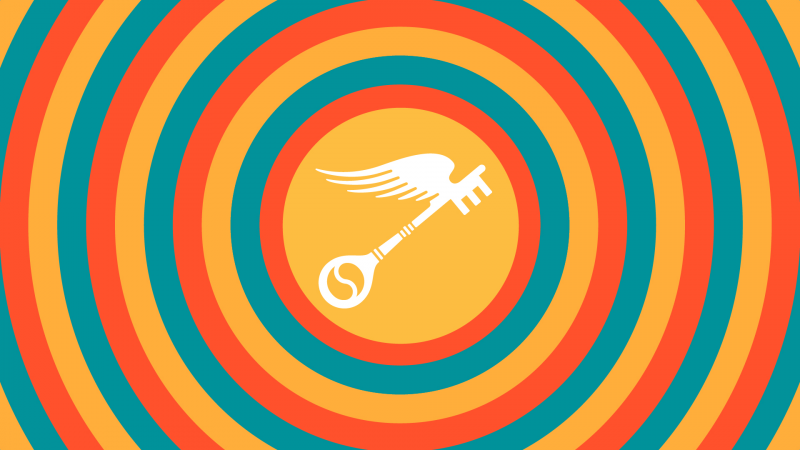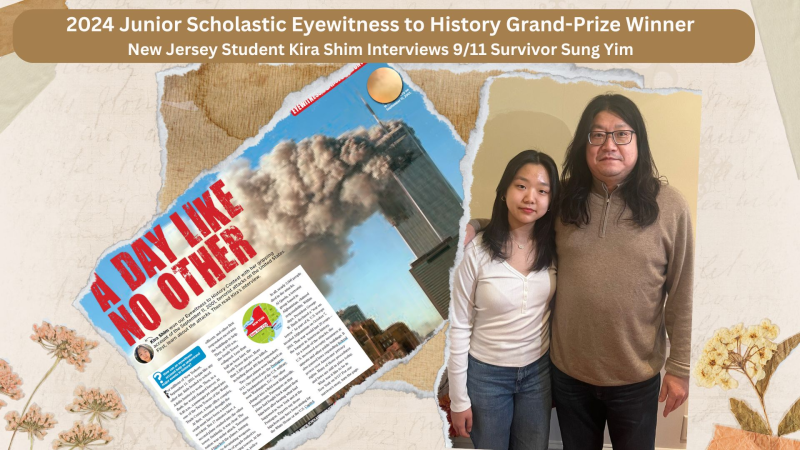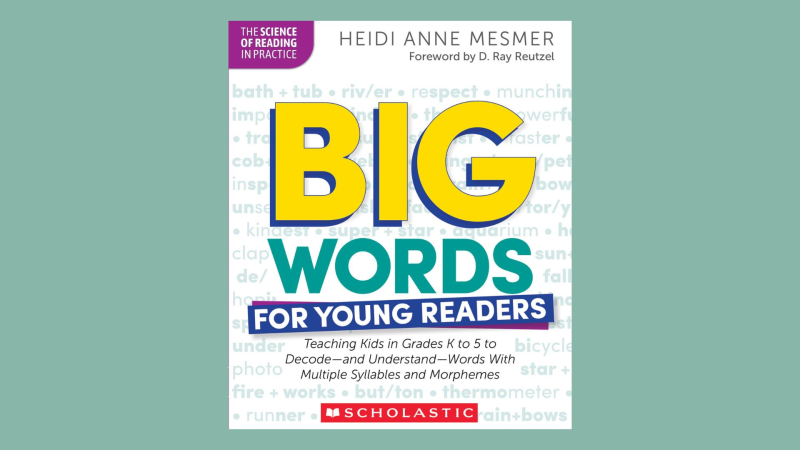In the 2020 Scholastic Art & Writing Awards, the Alliance for Young Artists & Writers recognized 16 high school seniors from across the country with the program’s highest national honor, the Gold Medal Portfolio, which includes a $10,000 scholarship. Throughout the month of May, we are highlighting and interviewing two pairs of Gold Medal Portfolio recipients a week prior to their national ceremony in June. We asked each recipient a few questions about their nationally recognized portfolios, craft, and future plans. And, to make it more interesting, students also asked each other a question to get to know their fellow gold portfolio medalists.
In this installment, we checked in with two talented student writers: Jieyan Wang from Moscow, ID, and Sam Bowden from Wyoming, OH.

Meet Gold Portfolio recipient Jieyan Wang! In her nationally recognized writing portfolio, “The Dream of Life,” Jieyan experiments with magical realism, science fiction, and fantasy in a series of flash fiction and short stories that ultimately, through blurring lines between the real and unreal, make clearer sense of the world around her.
When did you first know you were a writer?
The moment when I picked up my pen, wrote for an hour, and couldn’t stop.
What was the inspiration behind your portfolio?
Even though the world can seem mundane, the human experience makes it colorful. Humans, through their thoughts and emotions, can turn the everyday world into something that is beautiful and vivid. In my portfolio, I try to convey this perspective by writing stories that augment the human perspective using the whimsical, strange, and surreal.
What do you want someone to take away from reading or looking at the pieces in your portfolio?
I hope that readers can come away with an increased appreciation of life and the world we live in. I hope that, in some way, my stories get its readers to pose questions about humanity, even if the answers cannot be reached.
What’s next for you? Will you continue to write/create art in your future?
I will be attending Harvard University this coming fall. There, I plan on studying English and comparative literature. As of right now, I anticipate writing to play a large role in my college career, both academically and extracurricular-wise.
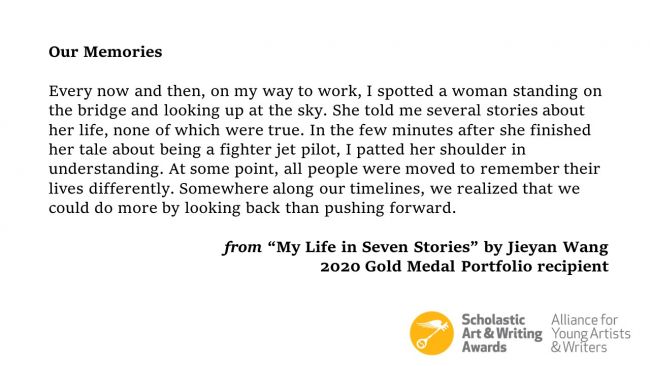
If you could have dinner with one notable/famous artist/writer (living or dead) who would it be and what would you want to talk about with them?
Franz Kafka’s work The Metamorphosis has long been a source of fascination for me. Combining elements of realism and the fantastic, “The Metamorphosis” tells the story of a salesman who has turned into an enormous insect. If Kafka were alive today, I would ask him: what does the unreal say about the real? What distinction, if any, divides reality and imagination?
From Gold Medal Portfolio recipient Sam Bowden: As someone who is comfortable in the longest form possible I am consistently boggled by writers who are able to convey so much in so few words. In your piece, “My Life in Seven Stories,” it feels like you’re able to jump-cut through a whole life in just a few hundred words. How do you streamline a piece like that? How do you go about trimming something down so it doesn’t trail on and on while still conveying everything you want it to?
For most of the flash fiction pieces that I write, I don’t feel like I’m “trimming” anything down. Rather, the story that I’m creating demands brevity. It wants to fit itself into a small amount of space, and it doesn’t need a large number of words to make its impact. My stories are living beings to me; when I write, I try to figure out what they want to be.
On a less abstract note, I think that flash fiction doesn’t always have to be about telling the full story in a small space. “My Life in Seven Stories” contains seven vignettes, each of them from a different time period in the narrator’s life. While many events between the vignettes are left out, the vignettes still portray the essence of the narrator’s life story. They show an emotional arc of loneliness, anxiety, and nostalgia. Flash fiction, by having so few words, also asks the reader to pay more attention to each individual sentence. This, combined with the distillation of a larger story, can make for a truly vivid and intimate reading experience.
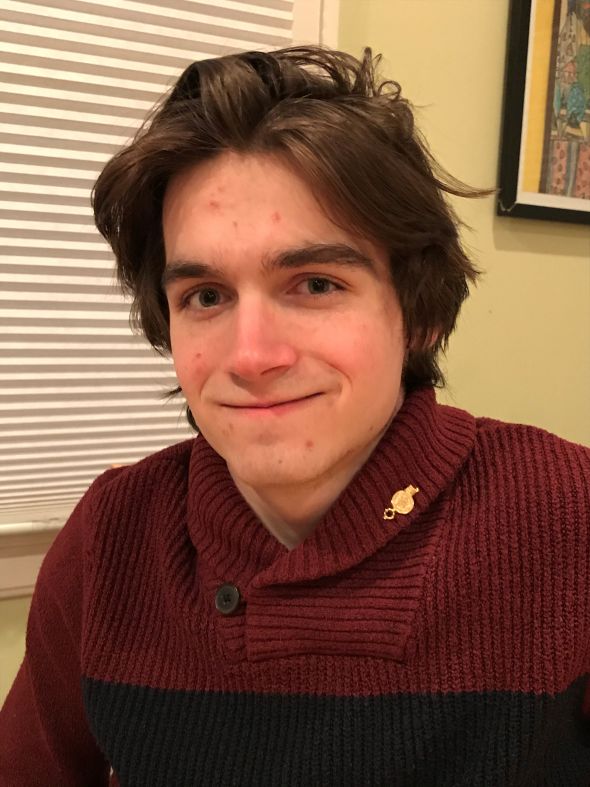
Meet Gold Portfolio recipient Sam Bowden! His nationally recognized writing portfolio, “Memento Mori,” is an exploration of death, and its effect on people, through a mixture of short stories and poems that blend humor, horror, and introspection.
When did you first know you were a writer?
I started writing—in the sense of creating my own story—in second grade, with a series of illegible stick-figure comic books that ran for fortysomething issues and all of elementary school. I didn’t think of myself as anything, writer or otherwise—I just liked being able to make and disappear into this other world. I gave up on the drawing part halfway through fifth grade—I was a hopeless artist—and tried to turn those comic books into short stories, novels, purely prose.
Really it wasn’t until I was fourteen and two weeks from entering high school that I started to think of myself as a writer. I finished my first complete novel just before turning fifteen and that proved the catalyst. I was a goner the rest of freshman year, writing almost continuously and finishing two more novels within a year. School didn’t matter; finishing that night’s chapter did. Finishing that first book led to this explosion of work that shaped what I do now.
What was the inspiration behind your portfolio?
There’s not a single source I can point to for the entire portfolio, since that isn’t how I wrote it—some of these pieces were sitting around on my computer for longer than a year before I dug them up and thought hey, this one might work. This is one of the main reasons the portfolio seems so diverse—I wrote many of these pieces at different times, when I was reading different books, when I was in different phases of developing as a writer. This is also why, when talking about that inspiration, I get to use “Cormac McCarthy,” “Car Seat Headrest,” and “The Stepford Wives” in the same sentence.
Without my knowing it, though, my personal life has infiltrated more of the pieces than I was expecting. I think that’s inherent to creation. Writers keep leaving bits of our brains all over our work. It’s like eating with bad manners. The essay at the end of the portfolio is based directly off of my life, but several pieces—like “His Hearth”or “clinging i + ii”or even “Not So Alone”—reflect this strange, heavily distorted, heavily allegorized image of myself.
What do you want someone to take away from reading or looking at the pieces in your portfolio?
I hope someone can finish my portfolio with a better understanding of me and, ultimately, themselves. I mentioned brain-bits previously. They’re the most basic, most human parts of me, the universality of art. By recognizing their own humanity—which I share—bent into whatever weird shape I felt like making that day, maybe someone can gain some new perspective or see themselves or their world in a way they hadn’t before.
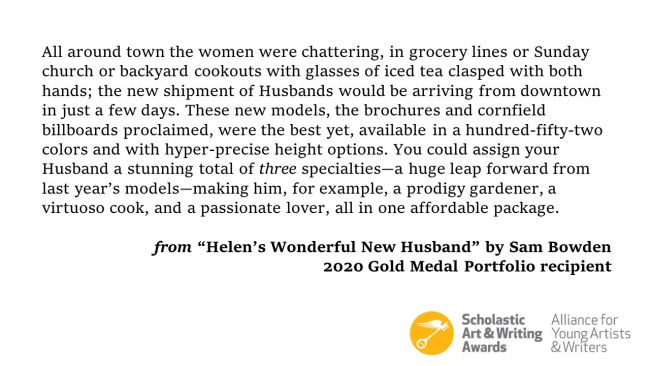
What’s next for you? Will you continue to write in your future?
Pending the collapse of Western civilization I’ll be attending (or logging into) Kenyon College in Gambier, Ohio in August, to pursue a double major in creative writing and, workload permitting, neuroscience. I will write until I drop dead or lose my eyesight, and the latter might not even force me to stop completely. I’ve finished writing and am now busy editing a series of novels, The Herald Trilogy, that I want to function as an absolute fulfillment of everything I want to achieve as a writer—an epic work with literary and genre value, following a boy in a future America whose reality starts literally collapsing around him. I want to start reaching out to publishers in college, see where I can go with it.
If you could have dinner with one notable/famous artist/writer (living or dead) who would it be and what would you want to talk about with them?
I spent too much time thinking about this. Currently I would have dinner with Marlon James. I would talk about everything and anything writing-related. Marlon James is very good at writing. It’s not fair.
Question from Gold Medal Portfolio recipient Jieyan Wang: In your short story “Helen’s Wonderful New Husband,” women are constantly buying new husbands and then brutally disposing of them. Do you think that a society could function if human life and relationships became manufactured products, purchased and replaced on a whim?
I think it depends on whether or not we consider human life to be a necessity of society. Maybe, in some utterly pragmatic world, there could be a functioning society monetizing/objectifying life or relationships. But the kinds of humans living in it wouldn’t be the humans everyone is now—we value emotion too much, place too much emphasis on connection being genuine, and to be able to take that and manufacture it, and affix monetary value to it, would require the destruction of a part of our humanity. Maybe. I don’t know. This made me think a lot.
Stay tuned next week when we get to know another pair of Gold Medal Portfolio recipients!
If you’re interested in learning more about past and present Gold Medal Portfolio winners visit the Eyes on the Prize series on the Alliance for Young Artists & Writers blog.
Cover photo: Courtesy of the Alliance for Young Artists & Writers; Photos in body: JIEYAN WANG, Headshot, Photograph; JIEYAN WANG, 'My Life in Seven Stories,' Writing; SAM BOWDEN, Headshot, Photograph; SAM BOWDEN, 'Helen's Wonderful New Husband', Writing.

